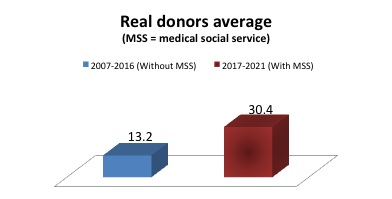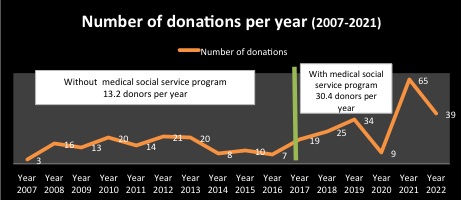How to increase organ and tissue donation with a low budget and better approach
Martha Susana Pérez Cornejo2,4, Ernesto Duarte Tagles1,3.
1Department of transplantation, Hospital General del Estado "Dr. Ernesto Ramos Bours", Hermosillo, , Mexico; 2Organ Donation Coordination, Hospital General del Estado "Dr. Ernesto Ramos Bours", Hermosillo, , Mexico; 3Department of transplantation, Hospital CIMA Hermosillo, Hermosillo, , Mexico; 4Organ Donation Coordination, Hospital CIMA Hermosillo, Hermosillo, , Mexico
Introduction: In Mexico, organ donation rate is of the lowest among latinamerican countries. Before COVID-19, deceased organ donor rate was 3.8 pmp (2019), for 2020 decreased to 1.2 pmp and by 2022 raised to 3 pmp, positioning Mexico in place 38 out of 47 countries according to the global observatory 2023 preliminary report. This low donation rate represents a major problem since waiting list still growing, having by may 2023 a total of 20,533 personas awaiting any kind of transplant. Due to disparity between people waiting a transplant and real donors, it is important to have programs that allows increase organ donation. In the other hand, México has the "medical social service program", it consists of last year med school students attending rural health centers in order to help in medical consultation in level one health programs. Recently, this program incorporated students attending urban and research centers, to help in health program in major cities as well. We proposed to have medical social service students to be involved in organ donation programs within a hospital 24/7, so can develop skills and knowledge in detecting potential donors that become real ones.
Method: we create an educational program that includes lectures about organ donation in fields like legal issues, detection and manintenance of potential donors, characterization of cornea, bone and skin donors as well as solid organs, family approach and all the process when a donation is carry out. At the same, students spend time in the organ donation coordination office and divide hours during day and night, in order to detect potencial donors all day.
Results: from 2007 to 2016 we had an overall donation rate of 13.2 donors per year.

This situation was done with only two persons working for organ donation program, representing a lot of potential donors not to be detected because in the hours death ocurred, no people in donation were notified and were not in hospital. In 2017 started social service program and in half of the time, we duplicate donation rate to 30.4 donors per year, being 2021 the one with the highest donors with 65. In year 2022, due to administrative changes, there were no more program and donations dropped to 39.

Conclusions: pandemic reduced organ donation worldwide, some countries are doing better but still much work to do. Having young medical social service doctors in organ donation coordinations demonstrate can be a good, safe and low cost programs that allow increase organ donation significatively. We end 2021 with a deceased organ donor rate in our hospital of 17.2 pmp, much higher than national of 1.2 pmp. We believe this kind of programs, making feasible to every latinoamerican countries that have medical social service such Ecuador, Guatemala, Venezuela, Bolivia, Costa Rica, Salvador, Honduras, Nicaragua, Panamá and Perú can help to have more organ donations and for instance, a higher transplantation rate.